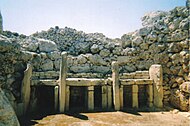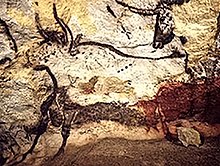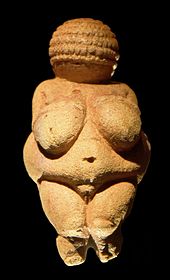History of art - Prehistory
Definition
The history of art focuses on objects made by humans in visual form for aesthetic purposes. Visual art can be classified in diverse ways, such as separating fine arts from applied arts; inclusively focusing on human creativity; or focusing on different media such as architecture, sculpture, painting, film, photography, and graphic arts. In recent years, technological advances have led to video art, computer art, Performance art, animation, television, and videogames.
The history of art is often told as a chronology of masterpieces created during each civilization. It can thus be framed as a story of high culture, epitomized by the Wonders of the World. On the other hand, vernacular art expressions can also be integrated into art historical narratives, referred to as folk arts or craft. The more closely that an art historian engages with these latter forms of low culture, the more likely it is that they will identify their work as examining visual culture or material culture, or as contributing to fields related to art history, such as anthropology or archaeology. In the latter cases art objects may be referred to as archeological artifacts.
Prehistory
The oldest human art that has been found dates to the Stone Age, when the first creative works were made from shell, stone, and paint. During the Paleolithic (25,000–8,000 BCE), humans practiced hunting and gathering and lived in caves, where cave painting was developed. During the Neolithic period (6000–3000 BCE), the production of handicrafts commenced.
The earliest human artifacts showing evidence of workmanship with an artistic purpose are the subject of some debate. It is clear that such workmanship existed by 40,000 years ago in the Upper Paleolithic era, although it is quite possible that it began earlier. Engraved shells created by homo erectus dating as far back as 500,000 years ago have been found, although experts disagree on whether these engravings can be properly classified as ‘art’.
Paleolithic
The Paleolithic had its first artistic manifestation in 25,000 BCE, reaching its peak in the Magdalenian period (±15,000–8,000 BCE). Surviving art from this period includes small carvings in stone or bone and cave painting. The first traces of human-made objects appeared in southern Africa, the Western Mediterranean, Central and Eastern Europe (Adriatic Sea), Siberia (Baikal Lake), India and Australia. These first traces are generally worked stone (flint, obsidian), wood or bone tools. To paint in red, iron oxide was used. Cave paintings have been found in the Franco-Cantabrian region. There are pictures that are abstract as well as pictures that are naturalistic. Animals were painted in the caves of Altamira, Trois Frères, Chauvet and Lascaux. Sculpture is represented by the so-called Venus figurines, feminine figures which may have been used in fertility cults, such as the Venus of Willendorf. There is a theory that these figures may have been made by women as expressions of their own body. Other representative works of this period are the Man from Brno and the Venus of Brassempouy.
 Blombos Cave engraved ochre
Blombos Cave engraved ochre Venus of Hohle Fels, an Upper Paleolithic figurine, the earliest known, undisputed example of a depiction of a human being in prehistoric art (ivory, height 6 cm (2.4 in))
Venus of Hohle Fels, an Upper Paleolithic figurine, the earliest known, undisputed example of a depiction of a human being in prehistoric art (ivory, height 6 cm (2.4 in)) Venus of Laussel, an Upper Paleolithic (Aurignacian) carving
Venus of Laussel, an Upper Paleolithic (Aurignacian) carving- Bison Licking Insect Bite, in carved antler, Museum of Prehistory, Les Eyzies-de-Tayac-Sireuil
 The Lion-man figurine after restoration in 2013
The Lion-man figurine after restoration in 2013 The Mammoth spear thrower, about 12,500 years old, rock shelter of Montastruc, Tarn-et-Garonne, France
The Mammoth spear thrower, about 12,500 years old, rock shelter of Montastruc, Tarn-et-Garonne, France The Shigir Idol, a 11,000 years old wooden sculpture, Historic Exhibition Museum, Yekaterinburg, Russia
The Shigir Idol, a 11,000 years old wooden sculpture, Historic Exhibition Museum, Yekaterinburg, Russia Hands at the Cuevas de las Manosupon Río Pinturas, near the town of Perito Moreno in Santa Cruz Province, Argentina
Hands at the Cuevas de las Manosupon Río Pinturas, near the town of Perito Moreno in Santa Cruz Province, Argentina
Mesolithic
In Old World archaeology, Mesolithic (Greek: μέσος, mesos "middle"; λίθος, lithos "stone") is the period between the Upper Paleolithic and the Neolithic. The term Epipaleolithic is often used synonymously, especially for outside northern Europe, and for the corresponding period in the Levant and Caucasus. The Mesolithic has different time spans in different parts of Eurasia. It refers to the final period of hunter-gatherer cultures in Europe and West Asia, between the end of the Last Glacial Maximum and the Neolithic Revolution. In Europe it spans roughly 15,000 to 5,000 BP, in Southwest Asia (the Epipalaeolithic Near East) roughly 20,000 to 8,000 BP. The term is less used of areas further east, and not all beyond Eurasia and North Africa.
Neolithic
| The Neolithic |
|---|
| ↑ Mesolithic |
|
farming, animal husbandry pottery, metallurgy, wheel circular ditches, henges, megaliths Neolithic religion |
| ↓ Chalcolithic |
The Neolithic period began in about 8,000 BCE. The rock art of the Iberian Mediterranean Basin—dated between the Mesolithic and Neolithic eras—contained small, schematic paintings of human figures, with notable examples in El Cogul, Valltorta, Alpera and Minateda.
Neolithic painting is similar to paintings found in northern Africa (Atlas, Sahara) and in the area of modern Zimbabwe. Neolithic painting is often schematic, made with basic strokes (men in the form of a cross and women in a triangular shape). There are also cave paintings in Pinturas River in Argentina, especially the Cueva de las Manos. In portable art, a style called Cardium Pottery was produced, decorated with imprints of seashells. New materials were used in art, such as amber, crystal, and jasper. In this period, the first traces of urban planning appeared, such as the remains in Tell as-Sultan (Jericho), Jarmo(Iraq) and Çatalhöyük (Anatolia).
Near East and Middle East
 Pillar 2 from Enclosure A (Layer III) with low reliefs of what are believed to be a bull, fox, and crane, from Göbekli Tepe (Turkey)
Pillar 2 from Enclosure A (Layer III) with low reliefs of what are believed to be a bull, fox, and crane, from Göbekli Tepe (Turkey) Tel Halaf terracotta fertility figurine, from 5000-4000 BC, Walters Art Museum
Tel Halaf terracotta fertility figurine, from 5000-4000 BC, Walters Art Museum Female figurine from Samarra, Louvre
Female figurine from Samarra, Louvre "Mother Goddess from Çatalhöyük", made of baked clay, (Turkey), neolithic age (about 5750-5700 BC), Çatalhöyük, today, Museum of Anatolian Civilizations(Ankara)
"Mother Goddess from Çatalhöyük", made of baked clay, (Turkey), neolithic age (about 5750-5700 BC), Çatalhöyük, today, Museum of Anatolian Civilizations(Ankara) Fragment of a ceramic bowl made by the Halaf culture, circa 5600–5000 B.C., Metropolitan Museum of Art (New York City)
Fragment of a ceramic bowl made by the Halaf culture, circa 5600–5000 B.C., Metropolitan Museum of Art (New York City) Yarmukian pottery vessel, Sha'ar HaGolan
Yarmukian pottery vessel, Sha'ar HaGolan Yarmoukian culture figurines at the Israel Museum (Jerusalem)
Yarmoukian culture figurines at the Israel Museum (Jerusalem) Twin goddess. Marble statuette, height 17.2 cm, from Çatalhöyük, 6000-5500 BC. Museum of Anatolian Civilizations (Ankara, Turkey)
Twin goddess. Marble statuette, height 17.2 cm, from Çatalhöyük, 6000-5500 BC. Museum of Anatolian Civilizations (Ankara, Turkey)
Eastern and Southeastern Europe
- Boian culture pottery exposed in Bucharest History Museum
- Mother goddess of the Cucuteni–Trypillia culture, Piatra Neamț Museum (Romania)
- Bowl on stand, Vessel on stand, and Amphora. Eneolithic, the Cucuteni Culture, 4300-4000 BCE. Found in Scânteia, Iași, Romania. Collected by the Moldavia National Museum Complex
 The enthroned "Lady of Pazardžik" of the Karanovo VI culture (c. 4500 BC)
The enthroned "Lady of Pazardžik" of the Karanovo VI culture (c. 4500 BC)- The "Sitting woman" and the "Thinker" of Hamangia, made by the Hamangia culture, National History and Archaeology Museum, Bucharest
 Neolithic clay amulet (retouched), part of the famous Tărtăria tabletsset, dated to 5500–5300 BC and associated with the Turdaş-Vinča culture. The Vinča symbols on it predate the proto-Sumerianpictographic script. Discovered in 1961 at Tărtăria
Neolithic clay amulet (retouched), part of the famous Tărtăria tabletsset, dated to 5500–5300 BC and associated with the Turdaş-Vinča culture. The Vinča symbols on it predate the proto-Sumerianpictographic script. Discovered in 1961 at Tărtăria The "Vučedol Dove", emblem of the Vučedol culture
The "Vučedol Dove", emblem of the Vučedol culture The "Videle goddess", made by the Gumelnița–Karanovo culture
The "Videle goddess", made by the Gumelnița–Karanovo culture A bejeweled gold cup from Trialeti, made by the Trialeti culture, National Museum of Georgia
A bejeweled gold cup from Trialeti, made by the Trialeti culture, National Museum of Georgia- Amphora from the 16th century BCE, made by the Ottomány culture
 Female figure from Tumba Madžari, Republic of Macedonia
Female figure from Tumba Madžari, Republic of Macedonia
South Europe
 The Megalithic Temples of Malta
The Megalithic Temples of Malta- An altar in the Tarxien temple complex (Malta)
Far East
 A Chinese red pot with two "ears", Peiligang culture, c.6000-5200 B.C. On display at the Shanghai Museum
A Chinese red pot with two "ears", Peiligang culture, c.6000-5200 B.C. On display at the Shanghai Museum Jade cong with combined patterns of human and animal face, made by the Liangzhu culture
Jade cong with combined patterns of human and animal face, made by the Liangzhu culture Jade bi made by the Liangzhu culture
Jade bi made by the Liangzhu culture- Painted pottery, made by the Liangzhu culture
- Banshan phase of the Majiayao culture
 Pottery symbols of the Banpo culture
Pottery symbols of the Banpo culture Eagle-shaped ceramic vase, made by the Yangshao culture
Eagle-shaped ceramic vase, made by the Yangshao culture Large water vessel of the Yangshao culture
Large water vessel of the Yangshao culture Japanese Jomon vase for cooking, made in the flame-style, Metropolitan Museum of Art
Japanese Jomon vase for cooking, made in the flame-style, Metropolitan Museum of Art Middle Jomon vase, made in the flame-style
Middle Jomon vase, made in the flame-style Japanese Dogū figurine from the site Ebisuda of Ōsaki, Miyagi prefecture (1000–400 BC)
Japanese Dogū figurine from the site Ebisuda of Ōsaki, Miyagi prefecture (1000–400 BC)
South Asia
 Female figure from Mehrgarh, circa 5500-2400 BCE, made of terracotta, 9.5 cm (3⁄4 in) high, Barbier-Mueller Museum (Geneva, Switzerland). Part of the Neolithic ‘Venus figurines’ tradition, this figure's abundant breasts and hips suggest links to fertility and procreation. Her hair was probably painted black; brown ochre would have covered the body, and her necklace was probably yellow. Her seated posture, with arms crossed under the breasts, is common throughout the region, as is her extravagant hairstyle
Female figure from Mehrgarh, circa 5500-2400 BCE, made of terracotta, 9.5 cm (3⁄4 in) high, Barbier-Mueller Museum (Geneva, Switzerland). Part of the Neolithic ‘Venus figurines’ tradition, this figure's abundant breasts and hips suggest links to fertility and procreation. Her hair was probably painted black; brown ochre would have covered the body, and her necklace was probably yellow. Her seated posture, with arms crossed under the breasts, is common throughout the region, as is her extravagant hairstyle
Metal Age
The last prehistoric phase is the Metal Age (or Three-age system), during which the use of copper, bronze and iron transformed ancient societies. When humans could smelt metal and forge metal implements could make new tools, weapons, and art.
In the Chalcolithic (Copper Age) Megaliths emerged, and massive monuments of stone were built. Examples include the dolmen and menhir and the Englishcromlech, as can be seen in the complexes at Newgrange and Stonehenge. In Spain the Los Millares culture was formed, characterized by the Beaker culture, characterized by human figures with big eyes. In Malta, the temple complexes of Ħaġar Qim, Mnajdra, Tarxien and Ġgantija were built. In the Balearic Islandsnotable megalithic cultures developed, with different types of monuments: the naveta, a tomb shaped like a truncated pyramid, with an elongated burial chamber; the taula, two large stones, one put vertically and the other horizontally above each other; and the talaiot, a tower with a covered chamber and a false dome.
In the Iron Age the cultures of Hallstatt (Austria) and La Tene (Switzerland) emerged in Europe. The first was developed between the 7th and 5th century BCE by the necropoleis with tumular tombs and a wooden burial chamber in the form of a house, often accompanied by a four-wheeled cart. The pottery was polychromic, with geometric decorations and applications of metallic ornaments. La Tene was developed between the 5th and 4th century BCE, and is more popularly known as early Celtic art. It produced many iron objects such as swords and spears, which have not survived well to the 2000s due to rust.
The Bronze Age refers to the period when bronze was the best material available. Bronze was used for highly decorated shields, fibulas, and other objects, with different stages of evolution of the style. Decoration was influenced by Greek, Etruscan and Scythian art.
 Solar cart of Trundholm, from Denmark
Solar cart of Trundholm, from Denmark
Text is available under the Creative Commons Attribution-ShareAlike License













